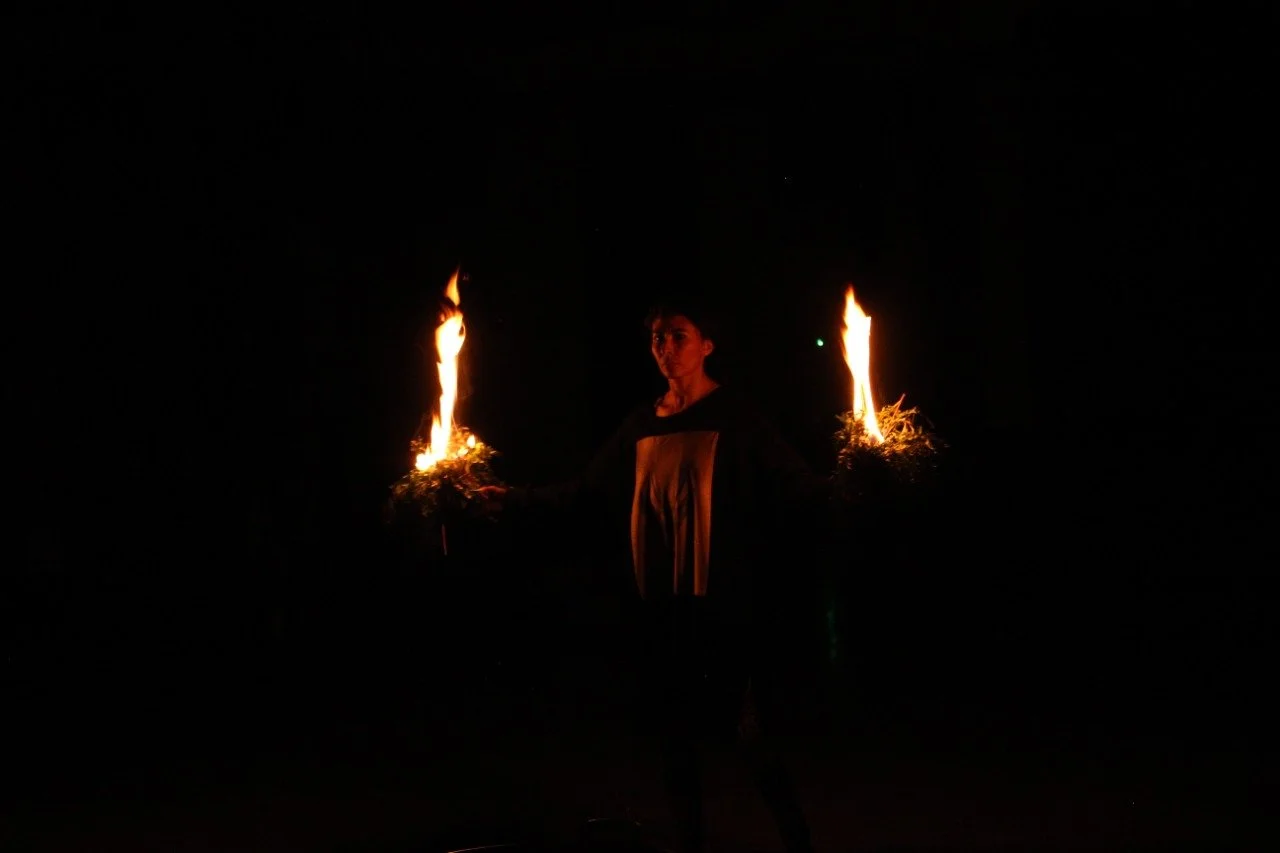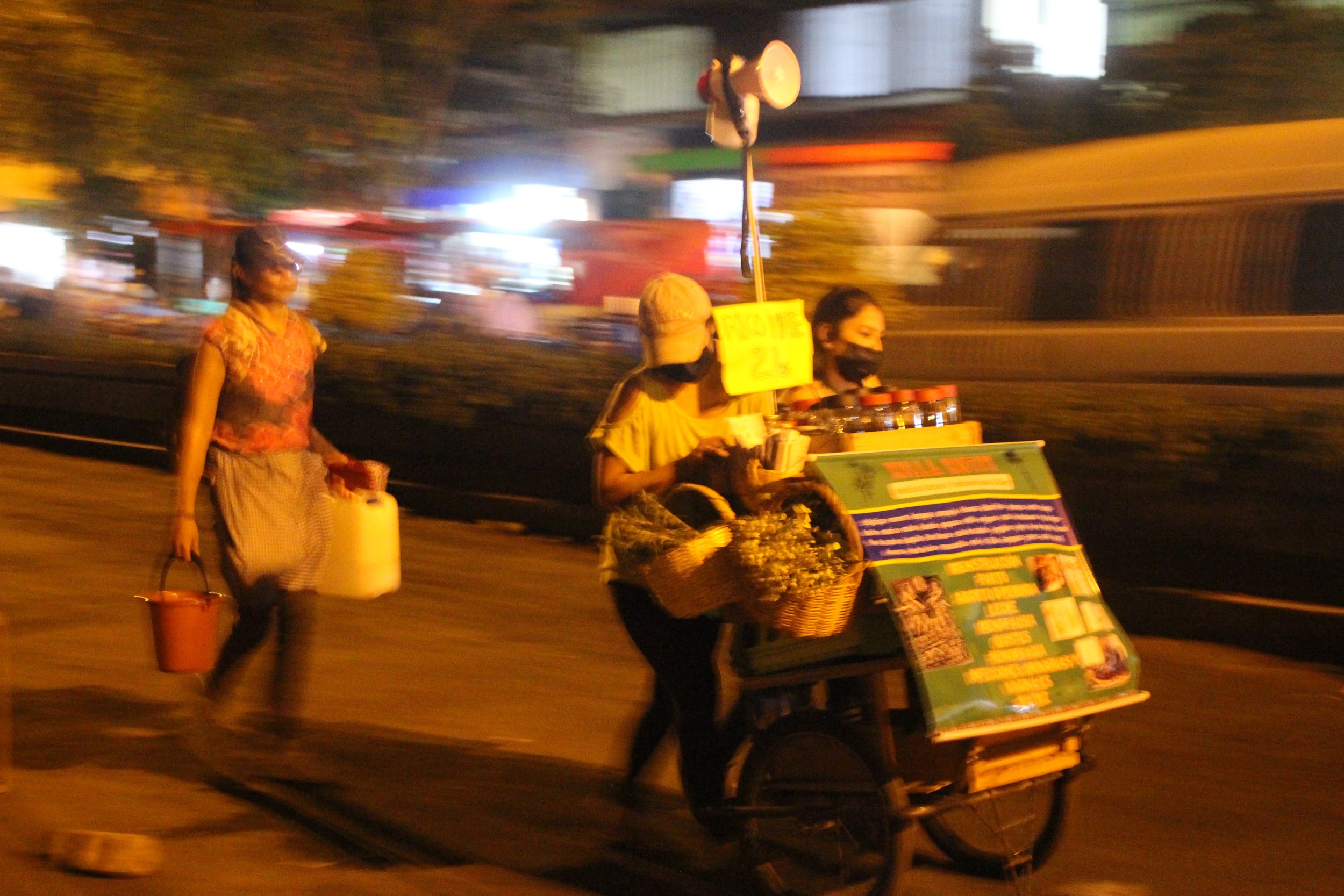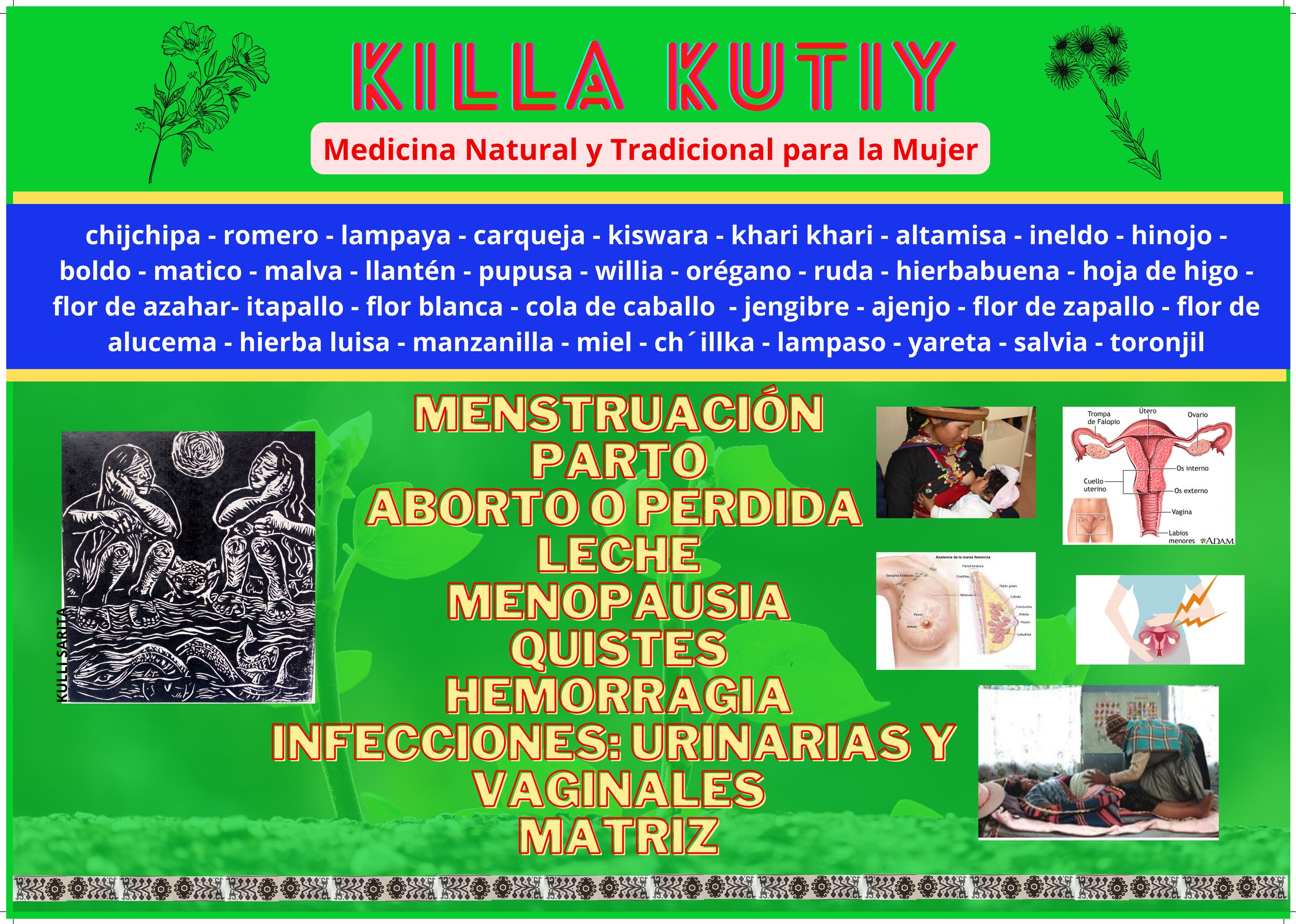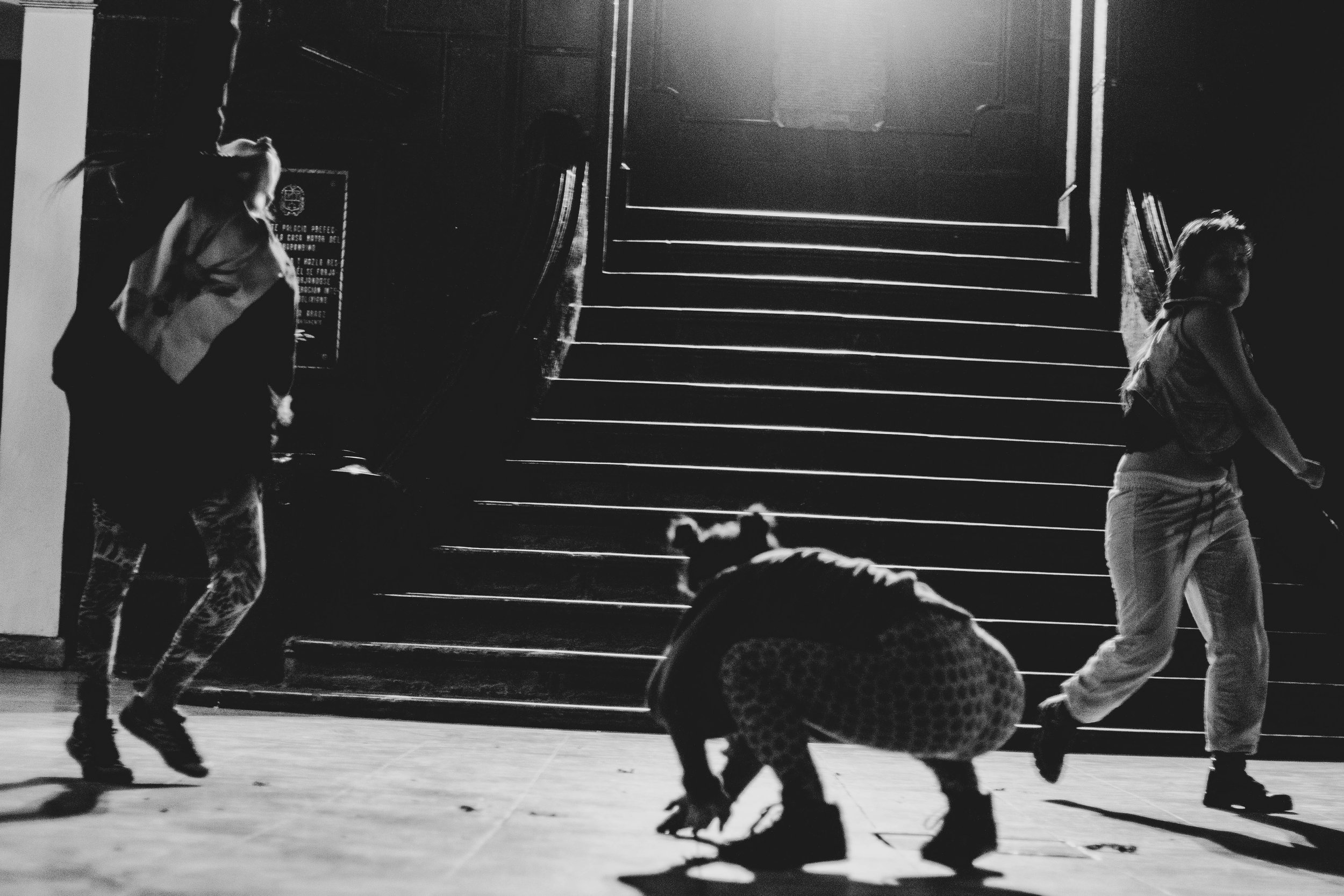Mujeres Subversivas: Bolivian and Diasporic Feminist Art & Activism
"To be Latinx is to be in constant combat. We fight against the hierarchies that exclude us and the ones built within us. Just like fruit, we bear the violent histories of dehumanizing labor and exploitation that continue to nurture the oppressor. The exportation of our fruits, like the battle, is eternal.”
–Natalia Barrientos, photographer
—
The illustration “Papa Imilla” (Imilla Potato) by Bolivian feminist illustrator and printmaker Adriana Herbas depicts two women locked in an embrace, their bodies suspended upside down, womb-like, under the surface of the earth. The figures are encased in roots, their long braids descending ever deeper underground. Upon closer inspection the braids themselves are made of intertwined potatoes–the “imilla” variety commonly used in soups and traditional meals in the Andes. Imilla is also the colloquial word for young woman in the Quechua language, a term used widely across the Central Andes of Bolivia and Peru. In an oppositional contrast, the bodies of the women are black, their figures outlined in the same clay color that makes up the earth they are encased within. As is typical of Adriana’s style, the figures’ hands and feet are heavily lined and pronounced, a representation of the callused hands and feet of Indigenous women in the Andes. As the potato roots reach the surface of the earth, they explode into the deep violet flowers of the papa imilla plant, a color that adorns the Andean countryside during the fall harvest in the agricultural cycle, just after the rainy season.
Adriana’s illustration adorns the cover of the forthcoming book Rajadura: Anthology of Lesbian and Bisexual Poetry, edited by Ros Amils and published by Tijeras Combativas. “Las imillas,” writes Adriana on her Instagram page, “emerge from ukhupacha,” a Quechua word that refers to the underworld in Andean cosmology. “They have shifted the earth and furrowed the paths so that the water can run, and with their kiss las Indias have made the earth flourish. May love between women nurture life, history, and rebellion.” Rajadura, the title of the poetry collection, connotes a crack, gash, or tear: a wound, a place of pain, but also power, potential, healing.
The enthralling work of Adriana Herbas is one expression of feminist artistic praxis in the Andes and Andean diaspora, part of a growing movement that fuses feminist and queer activism with elements of Indigenous identity, critique of patriarchy, and colonial rupture. As a Quechua-descendant artist that exists on the periphery between urban and rural livelihoods–Adriana’s family are farmers and she lives both in the city and the campo–her work draws on the ancestral lineage of Indigenous women torn from the earth and displaced from their territory, an ongoing rajadura that disrupted/disrupts innumerable generations of knowledge and thrusts that wisdom into trauma and clandestinity. In her book The Extractive Zone: Social Ecologies and Decolonial Perspectives, the scholar Macarena Gómez-Barris asks what it would look like if we tuned into the fragments of that knowledge. Gómez-Barris employs decolonial, feminist, and queer epistemologies–what she calls submerged perspectives–to explore the potential for crafting alternative modes of being and relating that confront the destructive forces of extractive capitalism.
Drawing from conversations with four Bolivian and Bolivian American artists about their artistic praxis, I expand Gómez-Barris’s submerged perspectives–an effort to see through to the other side of colonial capitalism—and pose a positionality of subversion. The work of the artists featured here all pulls from the thread of the colonial afterlife in different forms, manifest in works of illustration, photography, performance art, collage, and printmaking that interrogate themes of patriarchy, gender and sexuality, and Indigeneity. All four of these artists endeavor to make a living from their artistic practice while also challenging conventional notions of what art is and does, especially within the context of the conservative and religious value systems that dominate Bolivian society both locally and transnationally. The works of Adriana Herbas (Cochabamba), Dani Coca (New Jersey), Malena Rodríguez Garcia (Cochabamba), and Natalia Barrientos (Houston-Tarija) engage themes of identity, the body, and displacement. In expanding the creative and territorial boundaries of Bolivian art forms, these artists also blur false binaries between rural and urban, North and South, center and periphery, Indigenous and mestizo, departing from a place of self-identification and personal experience that complicates such totalizing narratives. “My artistic work is trenzado (braided, intertwined) with my political work,” says Adriana, “dialoguing and constructing always from a first-person perspective that reflects where I’m from: the earth, the female body, my [women’s] collective. My rage.” Operating from a subversive perspective, the works discussed here are generative, disobedient, and life affirming, inviting us to peel back the rajadura of patriarchy and coloniality, and imagine collective and artistic practices of resistance and joy.
Un Mundo Ch’ixi es Posible
In her 2018 book A Ch’ixi World is Possible: Essays from a Present in Crisis, the Bolivian sociologist Silvia Rivera Cusicanqui introduces the Aymara concept of “ch’ixi” as a subaltern decolonizing practice and frame of reference that prioritizes agency over passivity. While often associated with decolonial thought, Cusicanqui has long criticized decolonial studies and state policies as prefiguring a de-politicized condition that does little more than ornamentalize Indigenous culture at the hands of academia and the state. Cusicanqui therefore vindicates “lo ch´ixi” as an anticolonial practice engendered through conscious reflection and participation that resists state-sponsored processes of symbolic colonization.
As Cusicanqui explains, lo ch’ixi is “literally the mottled gray, formed from an infinity of black and white points that are unified in our perception, but remain pure and separate," serving to "acknowledge the permanent struggle in our subjectivity between 'lo Indio y lo europeo." Natalia Barrientos’ series Peregrino (2019) serves as an arresting example of la mirada ch’ixi, a series of blurred photographs depicting the annual religious festival San Roque in Tarija, Bolivia. Originating in the mid-17th century colonial period, the San Roque festival was named by UNESCO in 2021 as Intangible Cultural Heritage of Humanity. Founded in honor of a patron saint believed to have cured a leprosy outbreak, the festival features music, dancing, and dress representing los chunchos, an Indigenous group that once inhabited the tropical valleys of the Central Andes.
In Peregrino, Barrientos captures a kind of evanescent essence of the festival, through unfocused images that reveal the chaotic energy of the event, and bursts of color from the chuncho costumes that seem to recreate the rhythms of the music and dance. At the same time, there is a ghostlike quality, as if faint memories of the chuncho culture, now largely extinct, inhabit the blurred outlines of the dancing figures. Natalia’s series is also a fraught registry of patriarchy and fatherhood, as she attends the festival with her father after a long period of estrangement. “Between the tumult of the people, the costumes, the nostalgic music, the songs, and having been diagnosed with cancer, I sought to portray my father in the chaos of the party. We managed to share that moment of hope that he was going to be okay and that next year we would attend together again.”
Nevertheless, Natalia’s father did not survive his battle with cancer and the festival would be one of the last memories that they shared. Natalia now works as a professor of photography at the Catholic University in Tarija, a role she assumed after emigrating to the United States and completing a fine arts degree at the University of Houston. Despite living in the United States for many years, Natalia felt that she was never able to assimilate in a way that didn’t feel like a rejection of where she came from. It was while navigating that struggle of belonging that Natalia began to produce documentary works of video, collage, and photography based from family memories and archives. “We were so alone,” said Natalia of the years she spent in Texas living with her mother. “And my work started to explore the weight that family has in Latin America, this idea that we are always pulled back to our family, to our origins.” Those dynamics were challenging for Natalia, as her father–who was a public figure–had left the family and begun a new life with another woman. “I didn’t feel that I had a family here or there,” said Natalia, but being in Houston meant defining herself as a migrant more than defining herself as Bolivian. ‘I was never able to see Houston as my home. Never. It was always a place I was inhabiting and I said to myself, ‘at some point, I’ll leave.’”
Living and teaching back in Bolivia, Natalia doesn’t feel that she can share her work publicly because of the intimate nature of the materials and subjects she portrays. Works on her website include collages made from family photos and letters, and a video installation depicting her mother’s struggles with depression. While such works constructed from family archives and histories are not considered “art” in Bolivian society, Natalia finds that her photography students in Tarija are most interested in working with personal stories and family histories. “Here in Tarija there isn’t any kind of art world, or there’s a very basic notion of what art is. So I’m trying to do something for the chicos that are studying here. I want to give back in some way.” In her classes, Natalia prompts her students to explore themes that are generally considered taboo in Bolivian society: mental health, family dynamics, constructions of masculinity, and “what it means to make art in this country.”
While Natalia doesn’t view her work as political, I believe it is linked to a practice that Silvia Rivera Cusicanqui calls “la micropolítica,” or “elemental forms of everyday insurgency.” Functioning outside of formal political spaces, micropolitics are activated through “small collectives and bodily actions that allow spaces of freedom to flourish. We are looking to re-politicize everyday life, be it from the kitchen, work or garden… to articulate manual labor with intellectual labor, to produce thought from everyday experiences.” In her San Roque series Peregrino, in which figures in Indigenous dress reenact a colonizing Catholic ritual, Natalia blurs the lines between past and present, truth and reenactment, hope and illness–conveying just what Cusicanqui describes.
Bastard Feminism
The growing autonomous feminist movement in Bolivia owes much of its force and vitality to the renowned La Paz-based collective Mujeres Creando, co-founded by the anarcho-feminist activist María Galindo. Galindo has been disrupting the hetero-patriarchal status quo in the Andes for more than three decades through a myriad of tools and methodologies, including graffiti, performance and video art, urban interventions, a daily radio program, and writings on patriarchy and coloniality. Taking Cusicanqui’s theory of micropolitics to another level, Galindo’s praxis is centered on daily acts of disobedience and joy in the face of the entrenched racism and patriarchy that pervade Bolivian society. “I speak from a place of torture and violence, not to bear witness but to imagine happiness from a position of disobedience,” writes Galindo in her 2021 book Bastard Feminism (18).
Galindo’s own subversive practice is drawn from a long lineage of Andean Indigenous and chola women protagonists, who for centuries have forged strategies of everyday resistance, collaboration, and survival against multiple and overlapping dynamics of dispossession. Galindo coined the term “bastard feminism” as a way of naming the brutal contradictions inherent in the colonial legacies of a mestizo-Indigenous social fabric: “If we were to write a genesis on these lands, it would begin with the word rape. The first scene of creation that we would contemplate would not be that of Adam and Eve playing in paradise, but that of our mother being raped by our father. We have a direct link with the raped and we have a direct link with the rapist” (108). The struggle, she claims, lies not in the construction and objection of “the other,” rather “the deep hatred against the India that we carry within” (35).
Galindo’s response is to reject the forced binaries and heteronormativity that would seek to whitewash and conceal this history, and embrace the term bastard as “a space that legitimizes disobedience and cultural critique in all forms,” (38) not from a place of victimization but from a place of agency, memory, and joy. Like Galindo and Cusicanqui, Gómez-Barris notes that the nexus of anarcho-Indigenous feminisms is first and foremost an active positionality that centers the autonomous body as a source of knowledge and resistance. “It is an intellectual and vernacular formation,” writes Gómez-Barris, “that begins with modes of being, thinking, doing, and relating otherwise, that are experienced through the body and in relation to each other” (112).
Dani Coca (she/her and they/them) emigrated to New Jersey with their family in grade school, and while they were raised in a community with a strong Latinx presence, they didn’t grow up around other Bolivians. At times, Dani was envious of the strong Dominican and Puerto Rican communities around her, engendering “almost a sense of shame, because I didn’t get to see much of Bolivian culture growing up.” Dani pursued illustration in college, which opened up a creative space for them to explore their Bolivian identity and culture: “That’s how I learned to love myself,” says Dani, who is passionate about creating characters that reflect their queer and diasporic experience. Dani’s illustrations are bursts of bold, bright colors, predominantly featuring women. “The palettes I use are colors I remember from my childhood in Limoncito,” says Dani, referring to the town in Santa Cruz where they were born. “I’m starting a new series focusing on different ethnic groups in Bolivia, specifically the women because they speak to me more.” Dani pointed to the ethnic and regional divides that are often tensious in Bolivia, saying “I feel like our differences should be way more celebrated.” Their new series endeavors to highlight “certain groups that I feel are especially ignored,” like Bolivia’s Afro-descendant communities.”
Dani, 24, recently made their first gallery sale at a show at Jersey City’s PATH Commuter Gallery called “Pause Listen Love.” The piece is an oil painting on canvas titled “Lady in the Leaves,” featuring a portrait of a woman with Andean features set before a pre-Columbian archeological carving. The woman’s eyes are closed, highlighting the pronounced lines of her eyes, cheeks, and jawbones, but her demeanor conveys a commanding sense of power and vitality. While Dani’s works sometimes delve into themes of erasure and cultural loss, they always strive to make their work feel warm and light-hearted. “I want people to look at my work and think, ‘this makes me feel happy, I feel hugged by this.’”
Dani now supports themself as an illustrator, crafting colorful designs and branding for clients, but they dream of eventually creating stories for comic books and children’s media. “Immigrant households are not happy at first when you say you want to explore creative fields,” Dani says. But the work also brings them closer to their Bolivian heritage, as Dani consults their family frequently about Bolivia’s diversity and complexities. “I'd love to one day be able to push [my own] stories a little more and give some representation for little Bolivian kids that maybe also feel like me when I was a little kid, not seeing people like me depicted in the world around them.
In contrast to Dani, Malena Rodríguez García’s work is provocative, transgressive, even unnerving at times. Trained as a contemporary dancer in Chile, Malena is most inspired by creating public interventions and performance pieces that unsettle social norms and engage the audience directly. Most recently, Malena co-wrote, researched, directed, and performed in a multi-faceted dance and performance piece titled “Intersecciones Seculares: Proyecto Killa Kutiy” along with two other artists and researchers, Jud Rojas Villazón and Lucia Herbas Cordero. The work engages the feminine pharmacopeia within the Andean cosmogony, an ancestral plant, animal, and mineral knowledge that has been essential for economies of care and corporal autonomy among Indigenous women. “This knowledge constitutes a silent power that has woven the psychic resistance against the attacks of colonialism and the Republic; a female power passed on for generations that today survives harassed by western medicine, globalizing capitalism and the conservative morality that still persists in our society.”



In one dimension of the piece, the three artists created a mobile cart selling infusions of herbs with healing properties used for women’s health and wellness, from treatments for urinary tract infections to plant-induced abortions (abortion is criminalized and heavily stigmatized in Bolivia, although Indigenous women continue to harbor this knowledge in clandestinity). The three performers navigated the cart through the streets and popular markets of Cochabamba, selling the infusions while engaging in conversation with patrons and passersby about women’s health and autonomy. They also handed out pamphlets explaining the healing properties of different plants and herbs, in addition to colonial-era propaganda that sought to criminalize and demonize Indigenous women’s pharmacopeial knowledge.
The women also carried out an interactive dance performance that sought to evoke the following ideas and questions: “We think of the women’s body as a multidimensional space. What is the magnitude of a historical phenomenon? What is the volume and length that it encompasses in our bodies? How can it be measured? And if the phenomenon is several phenomena that reinvent themselves and establish new alliances in an evolving patriarchal pact, who would be the witches burned today?” The performance enacts a number of scenes inspired by Silvia Federici’s book Caliban and the Witch: Women, the Body and Primitive Accumulation, interspersed with readings from the audience of incantations, traditional healing practices, colonial testimonies of Andean witch hunts, and excerpts from Federici’s book.
In one scene titled “Becoming Animal,” featuring Malena dancing with her head concealed by an image of a deer head, an audio recording narrates the recent kidnapping and torture of nine Quechua women in Peru accused of practicing witchcraft earlier this year. The performance includes a quote from the 1486 treatise on witchcraft Malleus Maleficarum, written by German Catholic clergyman Heinrich Kramer, which was used during the Inquisition to justify a campaign of extermination against women accused of practicing witchcraft: "…we're here, on behalf of ourselves… abjuring our faith." Afterwards, the audience is invited to drink an herbal infusion and engage in discussion about the themes raised in the piece.
While more provocative than the work of Dani Coca, Malena’s artistic praxis similarly engages themes of Andean ancestral knowing and being that traverse their lives in disparate yet overlapping ways. Like Dani, Malena seeks to construct a life of creative practice–personally and professionally–that allows her to “continually reinvent my position in the world. I wish to live with a community of people who create spaces for reflection and the production of thought about the body and its affections and traversals. I want to create spaces for creative practice and movement research. I wish to have the necessary resources for the production of my desires."
Body as Territory
Adriana Herbas also combines the elements of provocation and joy, subversion and affection, that can be identified in Dani and Malena’s works. Adriana, who also goes by the artistic name Kulli Sarita (purple corn), produces works that are both somber and elevating, often depicting women engaged in mobilizing political action, or connected intimately to the agricultural cycles of the earth. The viewer is at turns embraced and enraged by her work; in one print, a woman sits on a weaving over a medicinal concoction, while her back is held by another woman that accompanies her. The two figures are surrounded by the arching outline of a snake that encases them in a kind of dark embrace. The body of the snake is supported by a series of hands, their bodies concealed, presumably of a number of faceless women who also engage–silently, clandestinely–in both the embrace and the imbibement of the infusion. The words across the snake’s back read “Desobediencia Acompañada” (accompanied disobedience), alluding to the widespread Latin American practice of accompaniment for women carrying out medical abortions in silence and secrecy. The themes and evocations of the piece are manifold: collective care, anthropomorphism, criminalization, Andean textility and cosmology, bodily autonomy, and subversion.
The works of each of these artists engage with themes of territory and displacement, situating the feminized body in a terrain of struggle encapsulated in the term cuerpo-territorio (body-territory). Credited to the Maya-Xinka comunitarian feminist Lorena Cabnal, cuerpo-territorio is an ontological and affective mode of organization and resistance that acknowledges the constitutive linkages between processes of territorial dispossession and destruction and patterns of violence against women. As the feminist sociologist Verónica Gago writes, the “idea-fuerza” of body territory “expands a way of 'seeing' from the bodies experienced as territories and from the territories experienced as bodies” (96) that serves as “expanded matter, an extensive surface of affects, trajectories, resources and memories” (99). In different forms, Adriana, Dani, Malena, and Natalia all experiment and negotiate within that expanded terrain, tracing their own bodies through experiences of displacement, cultural loss, rearticulation, and joy. Through that practice, they each contribute in their own way to the creation of Cusicanqui’s mundo ch’ixi. “It is a utopia,” says Cusicanqui “to think that we can really collectivize this vision and turn it into a resource for political action. But as a horizon, it gives us the possibility of rebellion.”
For her part, Adriana’s dreams are practical and utopian. "I want to learn as much as I can about engraving and printmaking, and then my dream is to have a printing press of women engravers so we can fill the streets with printmaking. And with that is the desire to inhabit and occupy the streets and the earth more than to inhabit social media. Because we have a lot of collective creative force that is very, very powerful.”
Julianne Chandler is a writer and educator based out of Cochabamba, Bolivia. Currently she is a graduate student at New York University, pursuing a dual master's in Global Journalism and Latin American & Caribbean Studies. Her research and reporting interests include gender and feminist studies and extractivism in Latin America.









